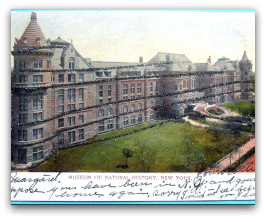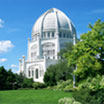Main menu
- ‘Abdu’l-Bahá’s Journey
- World Peace
- Stopping Racism in America
- Empowerment of Women
- More Principles...
- Prayer for America
The Master and the museum watchman

On Monday, 9 July, the Master invited me, with the Persians to go to the Natural History Museum. It was a broiling afternoon and I couldn’t imagine why He should want to go to that Museum, and in the hottest part of the day. But wherever He went, there I wanted to be.
When we reached the Ninth Avenue corner of the Museum the Master, exhausted by that time, sank to a low stone ledge to rest. Between us and the main door on the Central Park corner stretched a long cross-town block in glaring sun, not a single tree on the sidewalk.
“My Lord,” I said, “let me try to find a nearer entrance for You.” And I hurried along the grass, keeping close to the building, searching the basement for a door. The employees’ entrance was locked. Just beyond stood a sign: “No Thoroughfare.” I was rushing past this when a shrill whistle stopped me, and I turned to face the watchman of the grounds. He was a little bent old Jewish man with a very kind face.
“Oh excuse me,” I said, “for breaking the rules, but I must find a nearer door than the main one. See Who is sitting on that ledge! I must find it for Him.”
The watchman turned and looked at the Master, looked and looked, at that Figure from the East, from the Past—the Days of the Old Testament — and his eyes became very soft. “Is He a Jew?” he asked.
“A descendant of Abraham.”
“Come with me,” said the watchman. “Ask Him to come with me.”
I went over and spoke to the Master and He rose and followed with the Persians, I dropping back to walk with them. There was not a nearer entrance, but the watchman, taking a risk perhaps, led us across the grass, where at least it was cooler and the way shorter.
In the Museum we passed through a room in which a huge whale hung from the ceiling. The Master looked up at it, laughed and said: “He could hold seventy Jonahs!”
Then He took us straight to the Mexican exhibit, and this seemed to interest Him very much. In the great elaborately carved glyphs standing around the room He found traces of Persian art and pointed them out to me. He told us this sculpture resembled very closely the ancient sculpture of Egypt. “Only,” He said, “this is better.” Then He took me over to the cases where He showed me purely Persian bracelets.
“I have heard a tradition,” I said, “that in the very distant past this country and Asia were connected.”
“Assuredly,” answered the Master, “before a great catastrophe there was such a connection between Asia and America.”
After looking at everything in the Mexican rooms, He led us to the front door and out into the grounds again. Then, stepping from the stone walk to the grass, He seated Himself beneath a young birch tree, His back to us, while we stood behind Him on the flags. He sat there a long time, silent. Was He waiting for someone? I wondered.
While He — waited? — the old Jewish watchman stole quietly up to me from the direction of the Museum.
“Is He tired?” he whispered. “Who is He? He looks like such a great man.”
“He is ‘Abdu’l-Bahá of Persia,” I said, “and He has been a great Sufferer because of His work for the real Brotherhood of Man, the uniting of all the races and nations.”
“I should like to speak to Him,” said the watchman. And I took him over to the tree under which the Master still sat with His back to us.
At the sound of our footsteps He turned and looked up at the watchman, His brilliant eyes full of sweetness.
“Come and sit by Me,” He said.
“Thank You, Sir, but I am not allowed.”
“Is it against the rules for Me to sit on the grass?”
The old man’s eyes, softly shining, were fixed on the Master. “No, You may sit there all day!”
But the Master rose and stood beneath the tree.
Such pictures as I see when the Master is in them could never be put upon canvas — not even into words, except by the sublimest poet — but I always want to try at least to leave a trace of their beauty. The Master, luminous in the sunlight, His white robe flowing to the grass, standing beside the white slender trunk of the birch tree, with its leafy canopy over His head. The Jewish watchman standing opposite Him — so bent, so old — his eyes, like a lover’s, humbly raised to the face of his own Messiah! As yet unrecognized, his Messiah, yet his heart worshiped.
Eagerly he went on, offering all he could think of to this Mysterious One Who had touched him so deeply.
“You didn’t see the whole of the Museum. Would You like to go back after You have rested? You didn’t go up to the third floor.” (Unseen by us he must have been following all the time.) “The fossils and the birds are up there. Wouldn’t You like to see the birds?”
The Master answered very gently, smiling.
“I am tired of travelling and looking at the things of this world. I want to go above and travel and see in the spiritual worlds. What do you think about that?” He asked suddenly, beaming on the old watchman.
The watchman looked puzzled and scratched his head.
“Which would you rather posses,” continued the Master, “the material or the spiritual world?”
Still the old man pondered. At last he brought forth: “Well, I guess the material. You know you have that, anyway.”
“But you do not lose it when you have attained the spiritual world. When you go upstairs in a house, you don’t leave the house. The lower floor is under you.”
“Oh I see!” cried the watchman, his whole face lighting up, “I see!”
After we parted from the watchman, who walked with us all the way to the Ninth Avenue corner, leading us again across the grass, I began to blame myself for not inviting him to the Master’s house, forgetting that the Master Himself had not done so. Every day I meant to return to the Museum to tell the old man where the Master lived, but I put off from day to day.
When, at the end of a week, I did run over to the Museum, I found a young watchman there, who seemed to know nothing of the one he had replaced.
Had our friend “gone upstairs?”
Why had the Master visited a Museum of Natural
History in the hottest hour of a blistering July day? Had He instead visited a soul whose need was crying out to Him, to open an old man’s eyes so that he might see to climb the stairs, to take away the dread of death?
(Many years later, in 1947, Juliet wrote: There may have been two meanings to that visit to the Museum and the second meaning I could not have thought of till 1940, when I became so deeply involved in the Bahá’í work in Mexico and completely at one in heart and spirit with the believers there.)








